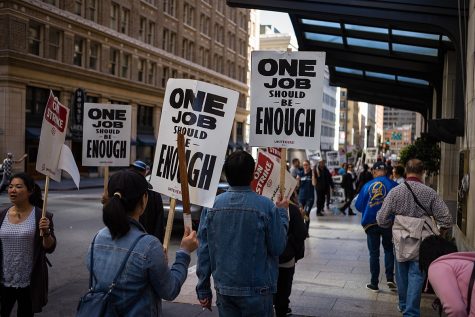The Great Resignation: America’s Declining Workforce
In this photo taken on June 15, 2021 a waitress wears a face mask while serving at Langer’s Delicatessen-Restaurant in Los Angeles, California, on California’s first day of fully reopening its economy after some fifteen months of Coronavirus pandemic restrictions. – California state regulators on June 17, 2021 have approved revised workplace pandemic rules ending most mask requirements for employees vaccinated againt the coronavirus. (Photo by Frederic J. BROWN / AFP) (Photo by FREDERIC J. BROWN/AFP via Getty Images)
U.S. labor shortages are expected to grow as more Americans leave the workforce as the global pandemic continues to incite a virulent economic recession, impacting minority groups the hardest.
Help wanted signs are plastered on the windows of numerous businesses all over the country. Pleading with millions of Americans to fill their vacancies. But instead of filling out resumes, people are sending out resignation notices.
Forbes reported, over 4.4 million Americans have quit their jobs as of September. Sending out 2-week notices has become a fad, and data reports show this trend will continue in light of the ongoing aftermath of the COVID-19 pandemic.
COVID-19 remains the biggest contributor to the current flailing job market. Because of this, employers are utilizing buy-back job applicants to recruit. A new survey conducted by Gallager shows that recruiters are finding new ways to compete for talent.
The pandemic influenced the way companies are now marketing their workforce to gain the attention of potential personnel interests. The report shows that benefit packages now include non-traditional coverage such as pet insurance. These new benefits are used as leverage to attract workers.
More companies are hiring and seeking to fill their positions —despite the COVID-19 Delta variant spreading rampant, hiring increased in July.
During the summer month, over 943,000 jobs were added. With the new Omicron variant going around, this spread remains a factor that will affect the job market tremendously.
Despite the ongoing labor shortages, the U.S. Labor of Statistics reports the unemployment rate fell by 4% in November. Additionally, new reports show that available jobs are increasing. The amount of people filing for unemployment has decreased by 21% as of October.
Although the U.S. unemployment rate has improved since last year’s recession, with nearly 10 million jobs available, according to the economic statistics reported by CNBC, businesses are having a hard time filling their workforce.
“We need an economy that has long-term restructuring. I think workers have come to realize it’s a zero-sum game to work in a job that doesn’t allow you to work, buy food, and pay for rent. Instead of having workers work three jobs to pay for rent. Workers are making the calculation that this is not a labor shortage, this is wage shortage, this a job quality shortage. People want to see the job quality improve,” said Lola Smallwood Cuevas, Project Director for the Labor Center at the University of California, Los Angeles.
Employment among African American women is facing the hardest dilemma for economic recovery. The U.S. Labor Bureau data found more than 500,000 Black women are no longer working.
“Black women saw the highest rate of unemployment from this pandemic in California. A lot more investments need to be made. Particularly, intentional sectors that employ Black women, so that we can get through this recovery. There have to be some very deep economic levers to change these conditions. These sectors are some of the most unregulated, with lowest paying jobs,” continued Cuevas.
Many of these job sectors remain unfilled. America’s burgeoning job demand does not mount up to the supply of workers available. Companies are scrambling to find ways to entice potential workers. Sign-on bonuses, increased salaries, and improved benefits packages are some of the many techniques businesses have used to fill positions.
Some companies have been successful in improving their employment vacancies. CNBC data shows that progressional and business services added 60,000, and transportation and warehousing gained 50,000. Other sectors such as healthcare, manufacturing, and financial activities have also contributed to the workforce population.
However, job placement is still coming up short, and the new variant is a significant cause of concern. The Omicron variant is inciting fears with the global economic infrastructure. The Guardian reports this new variant could exacerbate the dwindling workforce, urging the second wave of a worldwide shutdown. Consequently, shortages and inflation are expected to increase for a longer period.
The U.S. is not sitting idle as economic setbacks continue to rise. America is fighting back against labor scarcity through a myriad of measures to resume economic progression in light of the rapid influx of variants arising. Workers should stay mindful of the current sectors and opportunities that are influencing the economic workforce.
“It’s important to know you are the means of production. You have value and worth. Know what your rights are, connect with unions and other people in the workplace. This is a shifting and changing work environment, so be very mindful of the kind of sectors you want to enter into and what those will look like in the future. Give yourself some grace in the process,” concluded Cuevas.








